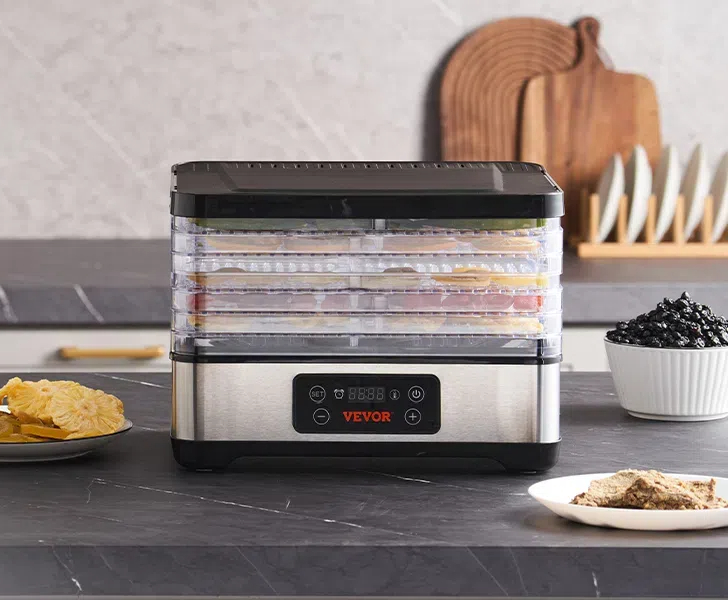
Content Menu
● Introduction
● What is Food Drying?
● Types of Food Dryers
>> Electric Food Dehydrators
>> Solar Food Dryers
>> Microwave Food Dryers
>> Oven Drying
● Benefits of Using Food Dryers
>> Preservation of Nutrients
>> Cost-Effectiveness
>> Convenience and Ease of Use
● How to Choose the Right Food Dryer
>> Capacity
>> Features
>> Brand Recommendations
● Step-by-Step Guide to Drying Food
>> Preparing Food for Drying
>> Setting Up the Dryer
>> Monitoring the Drying Process
● Common Mistakes to Avoid
>> Overloading the Dryer
>> Not Pre-Treating Certain Foods
>> Ignoring Temperature Settings
● Creative Uses for Dried Foods
>> Snacks and Trail Mixes
>> Cooking and Baking Applications
>> Pet Treats
● Conclusion
● Frequently Asked Questions
>> 1. What foods can be dried?
>> 2. How long does it take to dry food?
>> 3. Can I dry food without a dehydrator?
>> 4. How should I store dried foods?
>> 5. Are there any health benefits to dried foods?
Introduction
Food drying is an ancient preservation method that has stood the test of time. It involves removing moisture from food to inhibit the growth of bacteria, yeasts, and molds, thereby extending the shelf life of various food items. In today's fast-paced world, food drying has gained renewed popularity, thanks to the convenience of modern food dehydrators. This article will explore the ins and outs of food drying, including its benefits, methods, and tips for success.\

What is Food Drying?
Food drying is the process of removing moisture from food items, which helps to preserve them for longer periods. Historically, this method was used by various cultures to ensure food availability during harsh seasons. By reducing the water content, dried foods become lightweight, compact, and easy to store, making them ideal for long-term preservation.
Types of Food Dryers
There are several methods to dry food, each with its own advantages:
Electric Food Dehydrators
These appliances are designed specifically for drying food. They use low heat and a fan to circulate air, ensuring even drying. They come with multiple trays, allowing you to dry various foods simultaneously.
Solar Food Dryers
Utilizing the sun's energy, solar dryers are an eco-friendly option. They are best suited for regions with ample sunlight and low humidity.
Microwave Food Dryers
This method is quick and efficient, using microwave radiation to evaporate moisture. However, it requires careful monitoring to prevent overcooking.
Oven Drying
Your conventional oven can also be used for drying food. Set it to a low temperature and leave the door slightly ajar to allow moisture to escape.

Benefits of Using Food Dryers
Using a food dryer offers numerous advantages:
Preservation of Nutrients
Unlike canning or freezing, drying retains most of the food's nutrients, making it a healthy preservation method.
Cost-Effectiveness
Buying dried fruits and vegetables can be expensive. By drying your own, you save money and reduce waste.
Convenience and Ease of Use
Food dehydrators are user-friendly, often featuring timers and temperature controls that simplify the drying process.
How to Choose the Right Food Dryer
When selecting a food dryer, consider the following:
Capacity
Choose a model that fits your needs. Larger families may require a dryer with a higher capacity.
Features
Look for adjustable temperature settings, timers, and easy-to-clean designs.
Brand Recommendations
Some popular brands include Excalibur, Nesco, and Presto, known for their reliability and performance.
Step-by-Step Guide to Drying Food
Preparing Food for Drying
Wash and cut fruits and vegetables into uniform pieces to ensure even drying. Some foods may require blanching or pre-treatment to enhance flavor and color.
Setting Up the Dryer
Arrange the food on the trays, ensuring there is space between pieces for air circulation. Set the temperature according to the type of food being dried.
Monitoring the Drying Process
Check the food periodically to ensure it is drying evenly. Rotate trays if necessary.
Common Mistakes to Avoid
To achieve the best results, avoid these common pitfalls:
Overloading the Dryer
This can lead to uneven drying and longer drying times.
Not Pre-Treating Certain Foods
Some fruits, like apples and bananas, benefit from pre-treatment to prevent browning.
Ignoring Temperature Settings
Each type of food has an optimal drying temperature. Following guidelines ensures the best quality.
Creative Uses for Dried Foods
Dried foods are versatile and can be used in various ways:
Snacks and Trail Mixes
Create healthy snacks by combining dried fruits, nuts, and seeds.
Cooking and Baking Applications
Dried herbs and vegetables can enhance the flavor of soups, stews, and baked goods.
Pet Treats
Many pet owners use dehydrated fruits and meats as healthy treats for their pets.
Conclusion
Food drying is a practical and rewarding method of food preservation that offers numerous benefits. With the right equipment and knowledge, anyone can enjoy the advantages of dried foods, from enhanced nutrition to cost savings. Whether you're a seasoned chef or a home cook, incorporating dried foods into your diet can elevate your culinary experience.

Frequently Asked Questions
1. What foods can be dried?
Most fruits, vegetables, herbs, and meats can be dried. Popular choices include apples, bananas, tomatoes, and beef jerky.
2. How long does it take to dry food?
Drying times vary based on the type of food and the method used. Generally, it can take anywhere from a few hours to a full day.
3. Can I dry food without a dehydrator?
Yes, you can use an oven, microwave, or solar dryer to dehydrate food.
4. How should I store dried foods?
Store dried foods in airtight containers in a cool, dark place to maintain freshness.
5. Are there any health benefits to dried foods?
Dried foods retain most of their nutrients and can be a healthy snack option, providing fiber and essential vitamins.












